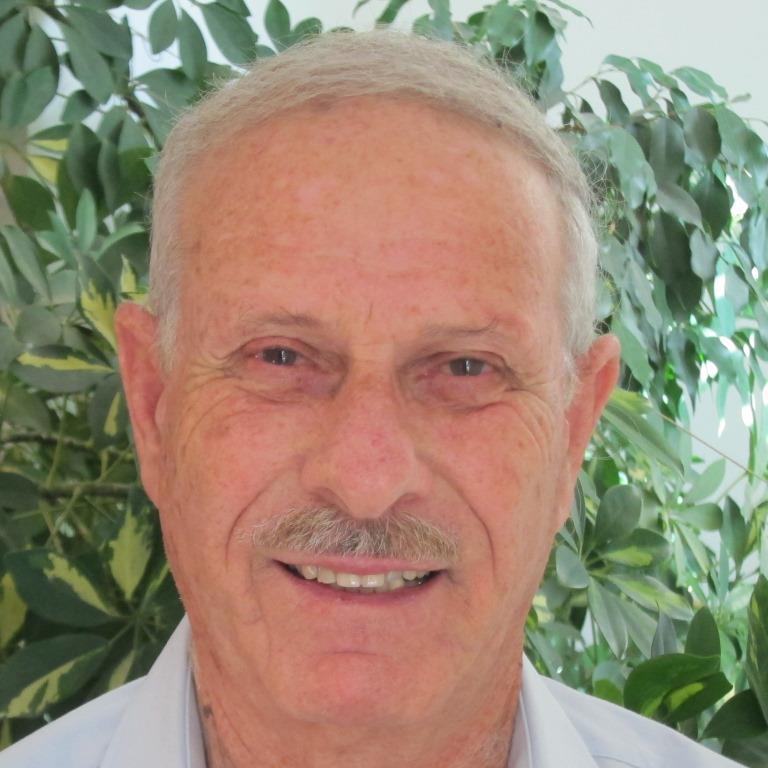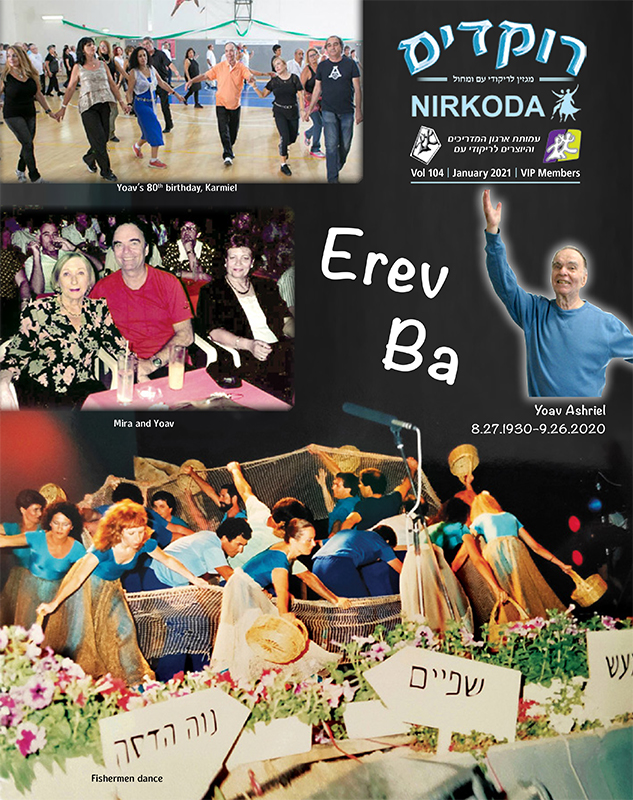- Home
- Rokdim Nirkoda 105
- His Frenetic, Rebellious Nature And His Dance Skills
His Frenetic, Rebellious Nature And His Dance Skills
Yoav's Childhood in the Kibbutz and its Impact on His Future Path
- Translation: Alex Huber
Yoav Ashriel was born (in 1930) on Kibbutz Ramat David (Einot) in the Jezreel Valley, where he spent his childhood and adolescence. Despite being a member of a kibbutz, with the distinct characteristics of the unique kibbutz figure of the 40s and 50s, in fact, Yoav‘s kibbutz period was quite short. Already at the beginning of his third decade of life, he had moved to Tel Aviv, however, according to the Kibbutz historians – a kibbutznik remained a kibbutznik.
Yaron Meishar and I traveled to visit Yoav‘s kibbutz to trace his childhood roots. Our destination was Dita Langlib‘s room on the outskirts of the kibbutz. We met with Dita, Yoav‘s best friend during his childhood and adolescence, about 80 years ago, and her daughter Ronit. We had a nostalgic conversation in which they shared Yoav‘s history on the kibbutz with us.
Dita defines herself as his closest friend during their childhood, even though she was one grade below him:
“We were just like a brother and sister”, Dita said. “We ran around on the kibbutz barefoot, free and happy. We were children of a kibbutz, who grew up in the children’s home, under the authority of idealistic educators, the guardians of the values of sharing and equality. We were a bit far from our parents, whom we met daily, for a few hours in the afternoon and evening. Even back then, I remember Yoav as a talented and creative child. At the age of 12 he invented a card game of pairs (man-woman, male-female dog, male-female rabbit) where he drew the cards himself. Yoav’s game became a hit in our group of children.
Another mischievous thing that we did, in complete secrecy as partners, was to brew ‘medicinal
ointments’ – we put various juices into empty bottles and hid them in pits we had dug in the ground.
As mentioned, we were ‘law-breaking’ children, walking around on the hot sand and in the manure in the cow shed, with Yoav in the lead. I remember once we went up to the top of the water tower, in just our underwear and tank tops, and we swam in the water.
I’ll tell you a secret; until the age of 12, we boys and girls showered together in the beit yeladim – children’s home and no one thought of it as something immoral. Yes, we even slept in the same room until the end of high school; that was equality!
Yes, I loved Yoav very much; it was a true friendship. Now, I am 90 years old. Shortly before his death, I called to congratulate him on his 90th birthday. It was a conversation full of longing and uplifting memories”.
Letter dated November 30, 1984, from Yoav to Dita:
Hello Dita
I was happy to hear from you on the phone and to renew old ties. I’ve remembered the beautiful childhood we had in Ramat David and everything related to it (without going into details …).
As I promised, I am sending you a published booklet, with the description of the steps of the most well-known dances I created. This booklet has been translated into English and distributed in the dance groups and to dance instructors in the United States and Europe. I visited many of them during my occasional instructional tours around the world.
I have a warm place in my heart for Ramat David, the way of life there and the area. It cannot be removed from me. With all the changes that have taken place, all the problems of life, my personal development and that of the whole family, it is always with me.
I really miss you. If I do not visit, it is not out of disrespect or malice God forbid, but out of developing circumstances.
I really want to hear a little more and keep in touch. Warm regards from Mira and the entire family.
Warm regards. Yoav
Rinka (Rina Shachar), “only” 85 years old, a few years younger than Yoav, and to this day, a member of Kibbutz Ramat David, recalls:
“When Yoav was 16 years old, he took it upon himself to lead a dance performance at a holiday event on the kibbutz. He gathered six girls, taught us the waltz rhythm and the dance steps he created for a one-time performance. For girls aged 11-12, it was a great feeling to stand on stage and perform in front of the kibbutz members. The youngster, Yoav, instilled a delightfully challenging spirit and a sense of elation in us to participate in a kind of show we had not known before. He had, at that time, already displayed the sparks of love for dance and choreographic creativity, which was a prelude to his immense future in the field of dance in Israel.
Yoav’s father, Moshe (Dovid) Glicksman, was a director; he directed plays in kibbutzim and, from him, Yoav attained the love of stage and theatricality. Yoav‘s mother, Hannah, was also part of the educational system, from whom this special man arose.
On one occasion, Yoav returned from the army and choreographed a Shavuot show based on the song ‘Shir HaEmek’. I, myself, participated in folk dancing as an adult, thanks to my first instructor, Yoav Ashriel”.
Kibbutzim Movement activities, the army and dance.
In Dita’s modest room, on the table in the living room, is a display of documents, books, photos, letters; sort of a Yoav Ashriel exhibition. A beautiful collection, a memorial to a good friend and a special person with a rich past. Among the memorabilia are letters that present a picture of Kibbutz life and the problems faced by the Kibbutzim Movement and its influence on this youngster, Yoav.
Here is a letter written on an old typewriter, which testifies to the importance of the young Yoav in the eyes of the leadership of the Kibbutz Movement. The letter was sent to Kibbutz Ramat David from the Histadrut of HaNoar HaOved – the Secretariat (exact quote),
To: Secretariat
Kibbutz Ramat David – Einot. Dated May 9, 1949.
Dear Friend.
On April 3rd, we asked you to send your member, Yoav Glicksman (Yoav’s original name. D.B.A.), to be a leader at Noar HaOved. Since then, we have not received an answer. It is difficult for us to understand this attitude towards us, especially when the decision is based on our opinion and that of the Secretariat of the Kibbutzim Association. Yoav is also ready to go to work.
We revisited our decision and agreed to demand that he become a leader for Noar HaOved. We ask that you do not postpone your approval and allow Yoav to leave for work as soon as possible.
With friendly greetings.
Secretariat of HaNoar HaOved. (The signature name is blurred.)
Copies:
Yoav Glicksman, Ramat David
Kibbutz Association Secretariat
And here is another letter concerning Yoav, which testifies to his frenetic, rebellious nature and to his dance skills, even then. And did the kibbutz leadership’s demand that Yoav be accepted as a leader in the Noar HaOved Movement?
A letter from the General Organization of HaNoar Ha’Oved Movement – The Secretariat. Dated October 9, 1949. (authentic quote)
To the Secretariat of the Einot Group.
Ramat David
Dear Member.
After the return of your son, Yoav Glicksman, from the Democratic Youth Festival (Yoav performed there as a dancer. D.B.A.), we asked him to continue his work in the movement. Yoav informed us that he wanted to return home. We see no justification for stopping his work in the movement after a month and the special circumstances in the movement do not allow this. Like any other member who works, Yoav must bear the collective responsibility of the movement’s workers. We demand that you insist that Yoav complete the period of work he had agreed to and fulfill his agreement. His claims, after listening to him, have not convinced us, and we are sure that this is a normal temporary crisis, and we insist that Yoav return to work, immediately.
Regards
Zeev Nechushtan. (With the stamp of the HaNoar HaOved Movement)
Copy: Yoav Glicksman, Einot
The above two official letters do testify to the power of the Kibbutz Movement of yesteryear, to dictate and demand of its members to fulfill a mission unconditionally, and to the rebellious conduct of the young Yoav towards the system.
We do not know for sure if Yoav agreed to accept the dictates of the Movement and return to leading at HaNoar HaOved after having worked there, according to this letter, for only one month. Presumably, Yoav, who was then a little over 19 years old and had already been selected to perform at a festival abroad, did not agree to the kibbutz leadership’s demand and did not return to be a youth leader in the HaNoar HaOved Movement.
According to the timeline, the youth leader story in the HaNoar Ha’Oved Movement took place after his military service and probably shortly before Yoav left the kibbutz for a long career in the field of dance in Israel.
On Wednesday, July 22, 1953, the 10th day of the month of Av 5713, an invitation for the wedding of Mira to Yoav was sent. It was handwritten and from (both sets of parents), Shifra and Reuven Bezparozvani and Hannah and Moshe-David Ashriel. The invitation was sent to friends, to attend the wedding of their children in the “Heichal Hamelacha Hall” in Tel Aviv.
It is not exactly clear when Yoav actually left the kibbutz, but in the IDF archives, I found out something about his activities in the 1950s. An article about Yoav Ashriel was published in the January 1958 issue of the magazine, “Bamachane Nahal”, under the headline “Annual Dance Gala”. Here are some excerpts from this article:
“Hundreds of people filled the room of the “Ahad Ha’am” School in Tel Aviv. Among them, a young and energetic man stood and gave feverish instructions, activating a team of young men and women who were the subject of interest of the large audience. It was an annual amateur dance event that was held a week ago and evoked much interest.
… The highlight of the event was a demonstration of four new dances presented by the dance troupe, “Pa’amei Machol”, which had been formed two months before. It aimed to cultivate folk dances in a pure Israeli style, while avoiding copying foreign dance styles. The director of the troupe is Yoav Ashriel. The dancers were former Ramat David residents, who set for themselves the goal of teaching and promoting Israeli folk dance through all possible avenues. For this year, about 700 people received letters of invitation sent by mail.
… Yoav also devoted his time to teaching folk dance in the working settlements (the kibbutzim and moshavim) claiming that the youth are looking for an original style in Israeli folk dance and remain indifferent to Slavic or American styles. He said that he himself finds his inspiration in the native born, Sabra, experience in the settlements, claiming that, “We will soon be able to reach greatness in ‘our’ style”. This is the quote from the publication, “Bemachane Nahal”.
As mentioned, the kibbutz chapter in Yoav‘s life was short, yet it was significant in his long life story. There is no doubt that the period of childhood and adolescence in the kibbutz influenced his work later in life and, of course, found its expression in his glorious dance body of work.









Comments
התראות